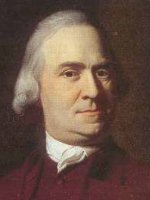Samuel Smith: Topsfield selectman
 Samuel Smith (1714-1785) was a selectman, legislative representative, and Committee of Correspondence member for the town of Topsfield, Massachusetts. But that's not why he attracts attention today. Many other men served their neighbors the same way, and Topsfield was not a major town then: third-smallest in Essex County. People still write about Samuel Smith because one of his great-grandsons, Joseph Smith, founded the Mormon church.
Samuel Smith (1714-1785) was a selectman, legislative representative, and Committee of Correspondence member for the town of Topsfield, Massachusetts. But that's not why he attracts attention today. Many other men served their neighbors the same way, and Topsfield was not a major town then: third-smallest in Essex County. People still write about Samuel Smith because one of his great-grandsons, Joseph Smith, founded the Mormon church.
According to some writers with Latter-Day Saints ties, Smith was involved in destroying the tea in Boston harbor on 16 Dec 1773. Indeed, this page at josephsmithsr.com says, "Capt. Samuel T. Smith was the ring-leader of the Boston Tea Party." [My emphasis—and I don't know where that middle initial sprang from.] In 2002, the magazine LDS Living published a travel article about Boston that passed on a similar claim, with some skepticism:
In short order we found ourselves in the Old South Meeting House. This is the church in which the patriots met when they engineered the Boston Tea Party. Great grandfather Samuel Smith, was chairman of the Tea Committee from Topsfield. Our darling cousin, Gracia Jones, assures us grandfather Smith, ancestor to the Prophet Joseph, was in on the party. Perhaps.The article shows a—let's say—casual approach to historical research, and makes some other missteps. For the record, British army officers were not locked out of Boston's huge tea meetings in 1773 since there were no officers in town then. The Rev. Thomas Prince of Old South did not go to England when war broke out; he had died in 1758. And there's no evidence Samuel Smith was in Boston on the night of the Tea Party.
Smith, a fifty-nine-year-old gentleman farmer who probably did most of his trading in Salem, was highly unlikely to travel thirty miles to Boston and spend the night hoisting and chopping open heavy chests of tea. The Boston Whigs didn't need his help; they had plenty of local volunteers. No first- or second-hand reminiscences of the event mention Smith.
Looking at Topsfield town records shows how this myth sprouted. In 1773 Smith and his fellow selectmen called a town meeting
To see if the Town will agree in sentiments with the Inhabitants of the Town of Boston, and many Other Towns, Respecting Teas being Exported into this, and the Other north American Colonys, by the East India Company on their own account, with a duty Imposed on it, for the purpose of raiseing a revenue in AmarcaSmith moderated that meeting, and his neighbors chose him first for a committee
to Consider & make Report to ye Town, what they think is proper for the Town to do Respecting ye East India Company sending Tea here on their own account.Thus, Smith was chairman of Topsfield's committee on the tea crisis.
However, the selectmen didn't call that town meeting until 27 December, over a week after they'd heard about the tea destroyed in Boston. The warrant for the meeting asked
if the Town will agree in sentiments with the Inhabitants of the Town of Boston Respecting their Late Conduct and proseedings in Regard to ye Tea, and the manner of its being Exported &C, as set forth in a pamphylet, and Other papersTopsfield's Whigs were responding to news from Boston, not making news there.
On 20 January, Topsfield’s town meeting accepted its committee’s report calling for a boycott on British tea, and affirmed that Topsfield voters
highly approve of every Legal Method the Town of Boston and Others have taken to prevent said Companys Tea being Landed, and to have it Sent Back from whence it Came.The town (under Smith’s leadership) thus positioned itself as fully in support of the law—while tacitly supporting extra-legal resistance to unjust new laws.
This committee was only one small part of Smith's political work for Topsfield. Because the Boston Tea Party became such an iconic moment of the pre-Revolutionary period, however, historians looking into Smith's life paid extra attention to it. After that, some eager writers read too much into those references. They spun Samuel Smith, chairman of his small town's committee to respond to the tea protest, into Samuel Smith, leader of the protest itself. But not every New Englander's great-grandfather was at the Tea Party.


 Yesterday's post
Yesterday's post